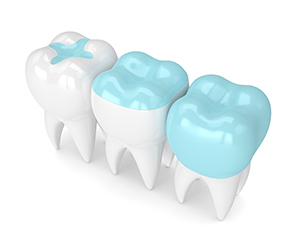Inlays/Onlays
Inlays and onlays are a type of indirect restoration, where your dentist fabricates the restoration outside of your mouth and cements it into place. A direct restoration, most commonly fillings, are placed immediately into a prepared cavity in a single visit.

Inlays and onlays are used in molars or premolars, when the tooth has experienced too much damage to support a basic filling, but not so much damage that a crown is necessary. They can be made of gold, metal alloys, ceramics, or composites. An inlay is used when the cavity rests between the cusps, whereas an onlay covers one or more cusps, as well as the area in between. A crown replaces the entire outside area of the tooth above the gum line.
Indirect fillings generally require two or more visits. During the first visit, your dentist prepares the tooth and makes an impression of the area to be restored. Your dentist then places a temporary covering over the prepared tooth. The impression is sent to a dental laboratory, which creates the dental restoration. At the next appointment, we cement the restoration into the prepared cavity and adjust it as needed.
Dentures
 Dentures have long been the solution of choice. Thanks to advances in technology and dental materials, today’s dentures are beautiful, comfortable, and functional. If there is adequate bone support often implants can be incorporated to increase the support of the dentures.
Dentures have long been the solution of choice. Thanks to advances in technology and dental materials, today’s dentures are beautiful, comfortable, and functional. If there is adequate bone support often implants can be incorporated to increase the support of the dentures.
Partial dentures
When some, but not all, teeth are missing, partials may be the solution. They are removable appliances, designed to fit around existing teeth. Dental bridges are permanently attached, and therefore more stable. This is especially true of implant-supported bridges. However, some people prefer partial dentures because they are faster than implants, and do not require existing teeth to be crowned, as bridges do. They are also a popular temporary solution for patients who are undecided about a permanent restoration.
Full Cosmetic dentures
A full denture plate is what you probably imagine when you hear the word dentures. They replace all of the teeth in an arch. Upper plates cover the roof of your mouth, and lowers are shaped like a horseshoe to fit around your tongue. Traditionally, they are designed to be snug fitting, which creates suction against your gums, holding the denture in place. The adhesive is available if suction alone is insufficient. Dr. Wheeler and Dr. Eroen have had advanced training in the precise construction of dentures. There goal is to create the best fitting and feeling dentures that can be made.
Today we can also offer the option of implant-supported dentures. They look like traditional full dentures, except they are typically smaller. Because suction is unnecessary, they do not need to cover as much gum tissue or the roof of your mouth. Dentures may be fitted with attachments that snap over implants or be permanently attached.
Bridges
 Whatever the reason for a lost tooth, replacing it is important. Gaps can compromise the health of your other teeth, cause difficulty chewing, and inhibit clear speech – besides being unsightly. Today, One of the most common solutions for missing teeth is dental Implants. However, when this cannot be accomplished another option is a dental bridge. A bridge can replace a single tooth or several teeth.
Whatever the reason for a lost tooth, replacing it is important. Gaps can compromise the health of your other teeth, cause difficulty chewing, and inhibit clear speech – besides being unsightly. Today, One of the most common solutions for missing teeth is dental Implants. However, when this cannot be accomplished another option is a dental bridge. A bridge can replace a single tooth or several teeth.
Types of bridges
The most common style is known as a traditional bridge. It consists of one or several false teeth (pontics) suspended between dental crowns. The teeth are made of quality dental Zirconia and porcelain, shaped and colored to match your existing teeth perfectly. The crowns are placed on existing teeth or dental implants. If existing teeth are used, they will need to be reduced and shaped to accommodate the crowns. This may be a practical option if teeth adjacent to the gap are compromised and need crowning.
Implant-supported bridges are an excellent option for most patients. They are more stable and last longer than bridges supported by teeth. There is no alteration to your existing teeth because the implants are placed in the jawbone. This is only recommended for patients who are missing several teeth; a single tooth can be replaced with a dental implant and porcelain crown.
Bonding

Bonding is a conservative way to repair slightly chipped, discolored, or crooked teeth. During dental bonding, a white filling is placed onto your tooth to improve its appearance. The filling “bonds” with your teeth, and because it comes in a variety of tooth-colored shades, it closely matches the appearance of your natural teeth.
Tooth bonding can also be used for teeth fillings instead of amalgam fillings. Many patients prefer bonded fillings because the white color is much less noticeable than the silver amalgam fillings. Bonding fillings can be used on front and back teeth depending on the location and extent of tooth decay.
Bonding is less expensive than other cosmetic treatments and usually can be completed in one visit to our office. However, bonding can stain and is easier to break than other cosmetic treatments such as porcelain veneers. If it does break or chip, tell your doctor. The bonding generally can be easily patched or repaired in one visit.

